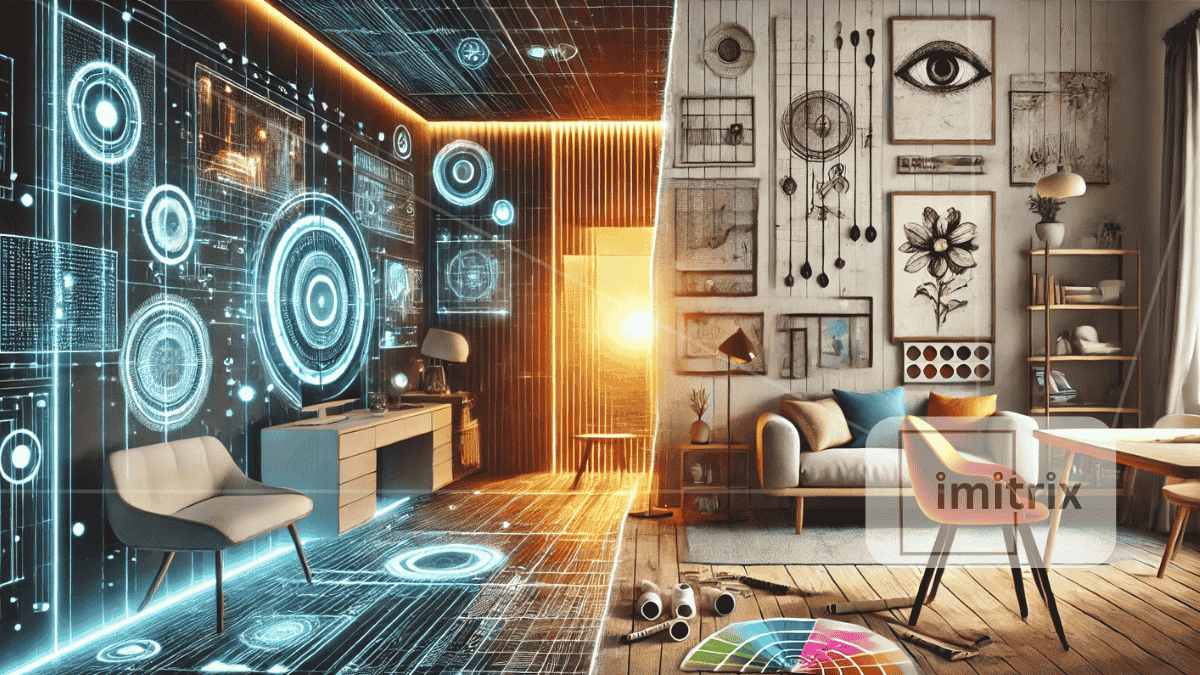AI vs. Human Designers is shaking up the home design world. Platforms like Modsy and Houzz Pro offer smart suggestions in seconds. But how do they compare to experienced human designers?
In this article, we pit AI vs. human designers across ten key categories: cost, creativity, speed, functionality, and more. Whether you’re renovating a home or furnishing a studio, this guide will help you choose the right approach for your next makeover.
Design Philosophy: Algorithms or Aesthetics?
At its core, home design is about solving problems—but also about feeling. A beautiful space isn’t just functional. It reflects personality and emotion.
Human designers excel here. They understand subtle cues, emotional context, and long-term needs. They can create spaces that feel personal.
AI designers, however, rely on data. They use algorithms to suggest furniture layouts and decor choices based on trends and input.
Winner: Human designers—for emotional depth and creative nuance.
Speed: Can Anyone Beat AI?
AI wins easily in this round.
Design apps can deliver a 3D mockup in minutes. You upload a room photo, select your style, and receive instant suggestions.
In contrast, working with a human designer takes time. Meetings, revisions, and sourcing furniture can stretch over weeks or months.
Winner: AI—for unmatched speed and efficiency.
Cost: Affordable or Premium?
AI-powered platforms are much cheaper than traditional design services. Many are free or charge under $200 per room.
Human designers, especially those with experience, charge hundreds per hour. Full-service design can run into the thousands.
For homeowners on a tight budget, AI offers a strong solution.
Winner: AI—for affordability and access.
Creativity: Original vs. Trendy
AI is great at imitating popular styles. Mid-century modern? Scandinavian? No problem.
But this is where human designers shine. They take risks, blend influences, and create one-of-a-kind spaces. Their designs feel personal, not templated.
Winner: Human designers—for originality and unique results.
Functionality and Space Planning
AI tools excel at layouts. They calculate measurements, optimize furniture placement, and even simulate lighting.
That doesn’t mean human designers fall short—but they can’t test 50 variations instantly.
Winner: AI—for layout precision and practical use of space.
Communication and Personal Touch
This is where AI vs. human designers takes a turn.
AI can interpret choices, but it doesn’t ask deeper questions. It won’t care if you love wine nights or your pet needs space to roam.
Human designers build relationships. They learn your story and design around your real life.
Winner: Human designers—for communication and personalization.
Scale: One Room or One Hundred?
AI can handle thousands of designs simultaneously. It’s perfect for developers, furniture retailers, and landlords.
Human designers handle fewer projects but offer deeper service. They’re essential for unique or complex spaces.
Winner: Tie—AI for scalability, humans for complexity.
Ease of Use: Who’s More Accessible?
Anyone can use AI design apps. No degree, no design background—just tap, scroll, and choose.
Human designers can feel intimidating to approach, especially for first-timers.
AI vs. human designers? On this point, AI levels the playing field.
Winner: AI—for approachability and DIY potential.
Best of Both: AI + Human Designers
Here’s the future: collaboration.
Some designers now use AI to streamline their workflow. Others offer hybrid packages, mixing automated mockups with personal consultation.
The smartest option might not be choosing between AI and a human designer—but using both.
Winner: The hybrid model—efficiency plus creativity.
Real-Life Examples
The Budget Renter
Lina used an AI app to redesign her studio for under $1,000. It matched her minimalist style, and she completed the makeover in one week.
The Custom Renovation
Matt and Priya hired a human designer for their four-bedroom renovation. She customized everything from lighting to layout and brought their vision to life.
The Developer’s Quick Fix
A property developer used AI to stage 30 condos. The entire project took two days and saved thousands.
Conclusion: AI vs. Human Designers – Who Wins?
It depends on your needs.
| Category | Winner |
|---|---|
| Speed | AI |
| Cost | AI |
| Creativity | Human Designers |
| Emotional Insight | Human Designers |
| Functionality | AI |
| Personalization | Human Designers |
| Scalability | AI |
| Complex Projects | Human Designers |
| Accessibility | AI |
| Overall Experience | Tie / Hybrid |
AI vs. human designers isn’t a one-size-fits-all debate. For quick, budget-friendly design, AI is unbeatable. For high-touch, custom work, humans still lead. In many cases, the best results come when they work together.
Tips for Using Both
Use AI tools for layout ideas and budget planning.
Hire a designer to refine your vision and personalize your space.
Combine both for speed, style, and a truly unique outcome.
Final Thought
Home makeovers are about more than furniture—they’re about feeling. Whether you go with AI, a human designer, or both, the best space is one that works for you.

